hORNS Symphony loudspeakers by Mike Wright
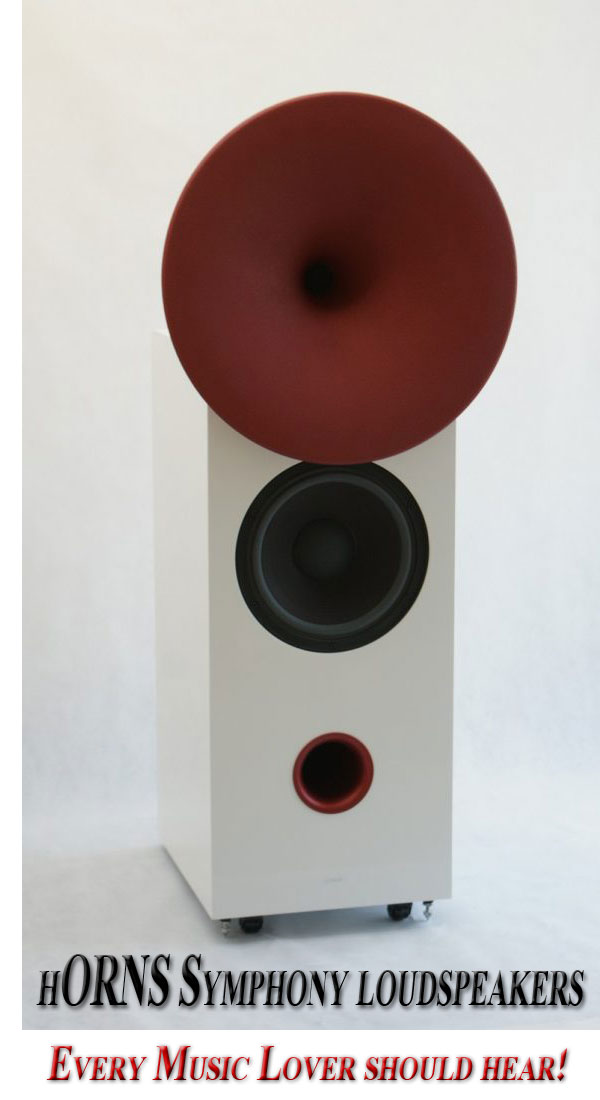
 “Wow. The hORNS Symphony speakers are actually sitting in my listening room.” The thought came to me the first time I started staring at how nice the Symphonies looked. As I walked around them, I saw how beautiful the woodwork was, felt how heavy and solid they were. The contrast of the white horn and the cabinet’s wood grain in this beautifully constructed speaker is just stunning. The next thing that came to mind was, “this is a speaker that every reviewer should experience.” A couple of weeks earlier, I contacted Robert Neill, President for Worldwide Wholesales and importer for hORNS speakers in North America. The hORNS speakers are built and designed in Poland by Lukasz Lewandowski, the CEO of hORNS.
“Wow. The hORNS Symphony speakers are actually sitting in my listening room.” The thought came to me the first time I started staring at how nice the Symphonies looked. As I walked around them, I saw how beautiful the woodwork was, felt how heavy and solid they were. The contrast of the white horn and the cabinet’s wood grain in this beautifully constructed speaker is just stunning. The next thing that came to mind was, “this is a speaker that every reviewer should experience.” A couple of weeks earlier, I contacted Robert Neill, President for Worldwide Wholesales and importer for hORNS speakers in North America. The hORNS speakers are built and designed in Poland by Lukasz Lewandowski, the CEO of hORNS.
We discussed some information I needed to get from him concerning the Rockna Wavelight DAC that I was working on a review for when he asked me if I would be interested in reviewing a pair of horn-designed loudspeakers. Usually, my reaction would have been to gracefully retreat from such a request. As nice as it would be to have a horn speaker review feather in my cap, I had not really been a fan of horn-designed speakers. Other than that great demo that Avantgarde Acoustic put on at the 2018 Axpona, I have usually found horns to be sometimes bright, aggressive or loud, and sometimes all three simultaneously. I know that’s not been the case every time I’ve listened to horns and that I’m being stereotypical, at best, but still, just not a fan. I said this to Robert Neill, and he assured me that this would be a different experience. Up to this point, everything he had given me his opinion on, whether it was the Wavelight DAC, the Inakustik 3500P conditioner and power cord, and a couple of other audio related things, he had been spot on. Even though I declared that I was shutting reviews down for the year (boy, was I ever wrong), I told him I would do it, if just for the experience if nothing else. A couple of weeks later, the loudspeakers, which were local to me at the time, were delivered.
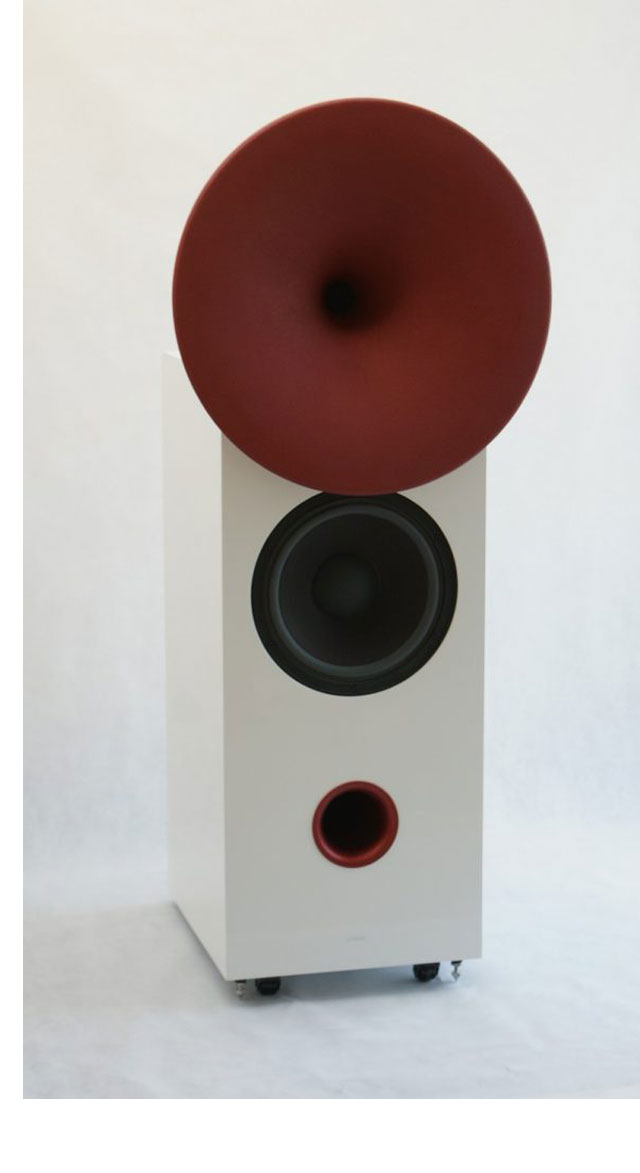 How They Look
How They Look
 The two delivery gents carefully unboxed the speakers and attached the horns. They offered to help with the setup, but I figured I would take my time and do it myself and thus released them to go back to work. The Symphonies are an extremely beautiful looking speaker. Any photo you can find of them online just will not do them any justice. Their fit and finish remind me of the best of what Germany’s Tidal audio company produces, which means fine furniture quality finishes that look good enough to fit in any fancy home. You do not know whether to listen to them or pull up a chair and stare at them. The Symphonies have that type of refinement. They weigh in at 165 lbs each but feel like they are heavier than that. My obliques were sore the next day after dancing with them, trying to get them dialed into my room. The Symphonies that I reviewed are the ones with the 13″ coated paper woofer/mid-woofer. There is also a Symphony with a 10″ woofer/mid-woofer. The Symphonies’ 13″ driver resides in a cabinet that measures 23.6″ D X 54.3″ H X 22″ W. The Symphonies are a two-way bass-reflex design that uses a 12dB per octave crossover. They have an 8-Ohm impedance and a sensitivity rating of 95dB. As I mentioned above, the horn flange is white and they have a 1″ X 2″ titanium driver but can be special ordered with a beryllium tweeter.
The two delivery gents carefully unboxed the speakers and attached the horns. They offered to help with the setup, but I figured I would take my time and do it myself and thus released them to go back to work. The Symphonies are an extremely beautiful looking speaker. Any photo you can find of them online just will not do them any justice. Their fit and finish remind me of the best of what Germany’s Tidal audio company produces, which means fine furniture quality finishes that look good enough to fit in any fancy home. You do not know whether to listen to them or pull up a chair and stare at them. The Symphonies have that type of refinement. They weigh in at 165 lbs each but feel like they are heavier than that. My obliques were sore the next day after dancing with them, trying to get them dialed into my room. The Symphonies that I reviewed are the ones with the 13″ coated paper woofer/mid-woofer. There is also a Symphony with a 10″ woofer/mid-woofer. The Symphonies’ 13″ driver resides in a cabinet that measures 23.6″ D X 54.3″ H X 22″ W. The Symphonies are a two-way bass-reflex design that uses a 12dB per octave crossover. They have an 8-Ohm impedance and a sensitivity rating of 95dB. As I mentioned above, the horn flange is white and they have a 1″ X 2″ titanium driver but can be special ordered with a beryllium tweeter.
Most importantly, the Symphony’s horns have a level control. More on this most critical feature later in the review. The Symphonies are a single-wire system in terms of placement, so there is no need for bi-wiring. There are leads that come up from the woofer/mid-woofer cabinet that attaches to the horns. I was told by Robert Neill, very seriously and with emphasis, to be sure to get them between 10-13′ feet apart, give them a slight toe-in with the center of the horn pointed towards my ears. He also stressed that the amount of space from the front and side wall needs to be exactly equal and that even being an inch or smaller off will affect how the speaker images. See why my obliques were so sore?
 One thing that amazed me during the setup was how the speakers settled into my carpet. I did a simple, basic setup that first night, getting them set up where I wanted them. The 2nd evening of setup, I experimented with toe-in and toe-out and made slight adjustments until I felt satisfied with where I had them. The Symphonies were 10′ apart, 7′ off the front wall with a small amount of toe-in. When I came downstairs to check my setup on the 3rd evening, they were not going to budge. They had settled into my carpet and were rock solid. Like a speaker version of Gandalf, from Lord of The Rings telling me, “You shall not move me!” I just stood back and said, “Okay.”
One thing that amazed me during the setup was how the speakers settled into my carpet. I did a simple, basic setup that first night, getting them set up where I wanted them. The 2nd evening of setup, I experimented with toe-in and toe-out and made slight adjustments until I felt satisfied with where I had them. The Symphonies were 10′ apart, 7′ off the front wall with a small amount of toe-in. When I came downstairs to check my setup on the 3rd evening, they were not going to budge. They had settled into my carpet and were rock solid. Like a speaker version of Gandalf, from Lord of The Rings telling me, “You shall not move me!” I just stood back and said, “Okay.”
How Do They Sound?
After I was satisfied that I had done a relatively good job of setup and that Robert Neill would not give me grief for my efforts, I sat down to do some listening. On the first track I played, I felt the sound was detailed, but it was tonally too bright and too aggressive for my taste. I was like, “Darn. I knew it. Here we go again.” Then I remembered the horn output level control in the back of each horn driver. Each horn was set to the 3rd notch. I dropped them both down to the second notch, queued the music back up, and have not looked back since. My initial reaction to the Symphonies after the horn output level change was, “Wow! So this is what horn speakers can sound like.”
I was experiencing sound that came from all around the room. The soundstage that the Symphonies replicated was wide and deep, with instrumentalists well-placed on the stage like I had not experienced before. The room ambiance and atmosphere on live recordings seemed reproduced much more realistic than what I had been used to. The Symphonies high frequencies were rendered with a lot of airiness and detail without being remotely close to sounding bright or aggressive like I expected them to be. The midrange breathed musical life and felt almost sonically tactile with a “reach out and touch” type of aliveness. The Symphonies’ bass performance was and surprisingly deep. I expected the lower registers to boom somewhat with a 13″ driver in such a large cabinet, but there was none. The bass was tight, extended, tuneful, and impactful. The dynamic contrasts that the Symphonies portrayed were fast, truthful, and on occasion, could sound startlingly real, especially if I had the volume turned up. A couple of times, the Mrs. had to question if I had lost my mind. I blamed it on the speakers. Tonally, the Symphonies sounded organic and truthful.
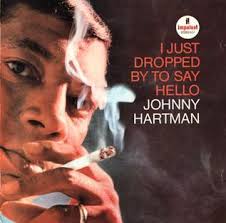 The Symphonies did such an excellent job of imaging that while I listened to Johnny Hartman singing “I Just Dropped By To Say Hello,” I walked up to his eerily present image and asked him if he had any money on him. He just ignored me and kept singing. I think someone told me to sit down. Classical music selections played through the Symphonies felt like the whole orchestra fit between and outside of the speakers. It was a breathtaking experience, and I understand why some of your classical music fans put such a premium on image placement. After I got over my initial excitement at hearing horn speaker imaging capabilities, I started to assess other areas of the Symphonies’ performance. The Symphonies can reproduce lifelike detail and transient response with ease and transparency. The midrange performance of the Symphonies was faithful and realistic. On Mark O’Connor’s Hot Swing Trio’s CD, In Full Swing, which features terrific performances by Wynton Marsalis and Jane Monheit, has excellent examples of this. At the beginning of “Honeysuckle Rose,” you can hear Mr. O’Connor playing the first few bars on his violin while tapping his foot to set the beat for the other musicians to follow. On Amber Rubarth’s recording, Session’s From The 17th Ward [Chesky], is another example of the Symphonies’ exceptional image placement capability. Many sounds come from the recorded environment and ambiance that you hear coming from all over your soundstage due to Chesky’s use of the binaural recording technique, which seemingly places the listener in the room with the musicians. Ms. Rubarth is a talented singer, for sure, and all of the performers are locked in across the stage. On tracks such as Tundra, Strive, and Novocaine, you can hear the traffic (car horns) outside the venue, during quiet passages, as well as cellist Dave Eggar’s breathing technique is easier to follow when played through the Symphonies. Hearing the notes from the violin, cello, and percussion kit decay into the room was excellent.
The Symphonies did such an excellent job of imaging that while I listened to Johnny Hartman singing “I Just Dropped By To Say Hello,” I walked up to his eerily present image and asked him if he had any money on him. He just ignored me and kept singing. I think someone told me to sit down. Classical music selections played through the Symphonies felt like the whole orchestra fit between and outside of the speakers. It was a breathtaking experience, and I understand why some of your classical music fans put such a premium on image placement. After I got over my initial excitement at hearing horn speaker imaging capabilities, I started to assess other areas of the Symphonies’ performance. The Symphonies can reproduce lifelike detail and transient response with ease and transparency. The midrange performance of the Symphonies was faithful and realistic. On Mark O’Connor’s Hot Swing Trio’s CD, In Full Swing, which features terrific performances by Wynton Marsalis and Jane Monheit, has excellent examples of this. At the beginning of “Honeysuckle Rose,” you can hear Mr. O’Connor playing the first few bars on his violin while tapping his foot to set the beat for the other musicians to follow. On Amber Rubarth’s recording, Session’s From The 17th Ward [Chesky], is another example of the Symphonies’ exceptional image placement capability. Many sounds come from the recorded environment and ambiance that you hear coming from all over your soundstage due to Chesky’s use of the binaural recording technique, which seemingly places the listener in the room with the musicians. Ms. Rubarth is a talented singer, for sure, and all of the performers are locked in across the stage. On tracks such as Tundra, Strive, and Novocaine, you can hear the traffic (car horns) outside the venue, during quiet passages, as well as cellist Dave Eggar’s breathing technique is easier to follow when played through the Symphonies. Hearing the notes from the violin, cello, and percussion kit decay into the room was excellent.
 An album I have been getting a kick out of is Tribal Tech’s Illicit [Mesa/Bluemoon]. I have been diggin’ a lot on some of the fusion I did not listen to in the 90s, but the sonics on this recording is exceptional and a lot better than I would have imagined. This Tribal Tech recording is dynamic, dynamic, dynamic. This group sounds sonically similar to Massive Attack, which is another group I’ve been listening to and enjoying quite a bit. Listening to dynamic contrasts on this recording, as played through the Symphonies, is fast, explosive, detailed, and exciting overall, especially with some intense bass laid down on some of the tracks. On tracks “Illicit” and “Aftermath,” you can feel the energy coming from Tribal Tech, especially with Scott Henderson’s guitar and Gary Willis’ bass, though all of the performers are outstanding. Listening to this album, as well as their album, Thick [Shrapnel] album, were outright gratifying and exciting hearing them through the Symphonies. I could say the same thing listening to Massive Attack’s recording Mezzanine [Virgin]. Sonically darker than Tribal Tech but still very similar for the dynamics, and mixture of synthesized sounds combined with electric guitar and that’s just not on the tracks, “Angel,” “Teardrop” and “Mezzanine,” all from disc one, but the remixes on disc two, such as “Metal Banshee,” “Teardrop,” and “Inertia Creeps.” All these selections, played with clarity and rhythmic drive, were rousing to listen to when conveyed through the Symphonies.
An album I have been getting a kick out of is Tribal Tech’s Illicit [Mesa/Bluemoon]. I have been diggin’ a lot on some of the fusion I did not listen to in the 90s, but the sonics on this recording is exceptional and a lot better than I would have imagined. This Tribal Tech recording is dynamic, dynamic, dynamic. This group sounds sonically similar to Massive Attack, which is another group I’ve been listening to and enjoying quite a bit. Listening to dynamic contrasts on this recording, as played through the Symphonies, is fast, explosive, detailed, and exciting overall, especially with some intense bass laid down on some of the tracks. On tracks “Illicit” and “Aftermath,” you can feel the energy coming from Tribal Tech, especially with Scott Henderson’s guitar and Gary Willis’ bass, though all of the performers are outstanding. Listening to this album, as well as their album, Thick [Shrapnel] album, were outright gratifying and exciting hearing them through the Symphonies. I could say the same thing listening to Massive Attack’s recording Mezzanine [Virgin]. Sonically darker than Tribal Tech but still very similar for the dynamics, and mixture of synthesized sounds combined with electric guitar and that’s just not on the tracks, “Angel,” “Teardrop” and “Mezzanine,” all from disc one, but the remixes on disc two, such as “Metal Banshee,” “Teardrop,” and “Inertia Creeps.” All these selections, played with clarity and rhythmic drive, were rousing to listen to when conveyed through the Symphonies.
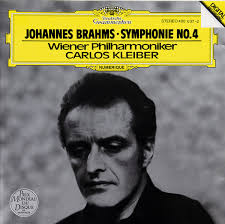 For my classical music entry, I enjoyed listening to Johannes Brahms’ Symphony No. 4 in E minor, Op. 98 by Carlos Kleiber and Wiener Philharmoniker [Deutsche Grammophon]. This a genuinely lovely, very steady piece of music that was easy to follow. Kleiber has a steadying grip on the orchestra, and it’s easy to sit back and get into the ebb and flow of the music. On this recording, I mainly took note of how the Symphonies allowed me to hear and follow the various sections of the orchestra, with its warm woodwinds and the vibrant tone of the strings. There are several interpretations of this work, but I felt Kleiber was one of the better ones, with the pace not being too slow. In the 4th movement, the music builds to a nice climax that the Symphonies were able to capture and let me feel the orchestra’s excitement.
For my classical music entry, I enjoyed listening to Johannes Brahms’ Symphony No. 4 in E minor, Op. 98 by Carlos Kleiber and Wiener Philharmoniker [Deutsche Grammophon]. This a genuinely lovely, very steady piece of music that was easy to follow. Kleiber has a steadying grip on the orchestra, and it’s easy to sit back and get into the ebb and flow of the music. On this recording, I mainly took note of how the Symphonies allowed me to hear and follow the various sections of the orchestra, with its warm woodwinds and the vibrant tone of the strings. There are several interpretations of this work, but I felt Kleiber was one of the better ones, with the pace not being too slow. In the 4th movement, the music builds to a nice climax that the Symphonies were able to capture and let me feel the orchestra’s excitement.
A Few More Thoughts
The Symphonies have this way with music that makes me fully understand why some folks are addicted to the sound of horns. Me personally, it could be hit or miss with most horns I have listened to. This experience has been so satisfying that I have become a believer in what horns have to offer, especially if you can deal with the tonal anomaly some horn speakers have. Once I got the hang of using the Symphonies’ output level control, I did not have any concerns with brightness or being driven out of the room when the music became loud. The other pleasantly surprising aspect of the Symphonies was the bass output. The Symphonies have an excellent bass response that meshed very well with the horn driver. The 13″ bass driver measured at 35hz as per the specs, but when the bass was demanding as from an orchestral tympani or synthesized bass, the Symphonies did a good job pushing out the air. I believe I was easily getting the in-room bass response that made it into the 20s. The sound emanating from the Symphonies is addicting in their ability to draw you into the music and allow you to feel not only the energy of the music but the expressiveness of the performers as well. On more than one occasion on albums where I would only listen to one or two or three tracks, I felt like I wanted to hear more of what the performer had to say. It was as if, somehow, I was beginning to connect with what they were trying to communicate. This has to be associated with the Symphonies’ clarity as there was more music there to relate to. I wish I had some comparison to make to explain how I felt about the sound coming from the Symphonies. The most concise description I can give is that they sounded more open, transparent, and more involving than many loudspeakers I’ve listened to, both planar and dynamic. I think in terms of my Tekton Moabs, which are a dynamic speaker with two 12″ drivers per speaker, the Moabs will play louder and with more control from the lower midrange down into the bass, and the Symphonies’ horns will play louder and with more control from the midrange up. I wouldn’t disagree with anyone who did not agree with me for any reason because I do not listen to music nearly as loud as some of my notoriously SPL unhinged friends. I enjoy listening to both loudspeakers quite a bit, but there is something about the Symphonies that I found to be addicting and enjoyable.
 One thing of note that I need to mention, to be fair, is that I did not listen to the Symphonies with a SET amplifier, as Robert Neill suggested. None of my audiophile buddies that I could borrow gear from has a SET amp that I could borrow, and I didn’t feel like making the rounds to one of the local audio salons to get one. This very well could have made a difference. Still, I thought I got better than expected results using a VAC 100 iQ with KT-88s instead of KT-120s and had surprisingly extraordinary results using one of Gilbert Yeung’s NSI-GY integrated amplifiers. This integrated is only rated at 85 watts/channel and was the closest thing I could get to a “lower-powered” amplifier. The sound of the combination of the Symphonies on the NSI-GY was very rewarding and special. I had to exercise patience, finding that balance between the tube and solid-state sound. However, once I made the adjustments to where I was happy, the sound was balanced and as close to neutral as I’ve ever been able to get out of a Blue Circle product (with a very little bit of warmth but a lot of detail and air). The bass was surprisingly deep, the stage was wide and especially deep and layered, and very detailed. The musicality level was off the charts. The only disappointing part of this episode was wishing I could have had more listeners hear what one of Gilbert Yeung’s masterpieces sounded like being played through the Symphonies.
One thing of note that I need to mention, to be fair, is that I did not listen to the Symphonies with a SET amplifier, as Robert Neill suggested. None of my audiophile buddies that I could borrow gear from has a SET amp that I could borrow, and I didn’t feel like making the rounds to one of the local audio salons to get one. This very well could have made a difference. Still, I thought I got better than expected results using a VAC 100 iQ with KT-88s instead of KT-120s and had surprisingly extraordinary results using one of Gilbert Yeung’s NSI-GY integrated amplifiers. This integrated is only rated at 85 watts/channel and was the closest thing I could get to a “lower-powered” amplifier. The sound of the combination of the Symphonies on the NSI-GY was very rewarding and special. I had to exercise patience, finding that balance between the tube and solid-state sound. However, once I made the adjustments to where I was happy, the sound was balanced and as close to neutral as I’ve ever been able to get out of a Blue Circle product (with a very little bit of warmth but a lot of detail and air). The bass was surprisingly deep, the stage was wide and especially deep and layered, and very detailed. The musicality level was off the charts. The only disappointing part of this episode was wishing I could have had more listeners hear what one of Gilbert Yeung’s masterpieces sounded like being played through the Symphonies.
I thoroughly enjoyed my time with the hORNS Symphony loudspeakers. I had no idea how enjoyable it could be to listen to a pair of horned speakers, and the Symphonies alleviated a whole host of fears and concerns and turned out to be one of my favorite pairs of speakers. For their looks, build quality, and above all, their outstanding sonic performance, the Symphonies get my “highest recommendation.” This is one of those products that, when it goes back home, will truly be missed.


mike wright
Specifications:
hORNS Symphony Loudspeaker
Woofer/midwoofer: 1×13″
High range 1×1″: 1×2″
Crossover: 12dB
Box: 135 l
Sensitivity: 95 dB
Frequency range: 35-20000 Hz
Impedance: 8 Ohm
Terminal: Single wire
Box dimensions (with horns): 600x1380x560 [mm]
Weight of speaker: 50kg
Price: $17,000.00/pair
Address:
hORNS
North American Distributor
Worldwide Wholesales
Email address: info@worldwidewholesales.com
Website: www.worldwidewholesales.com
phone: +1(519) 619-9924
Mike’s Associated Equipment:
Speakers
Tekton Design Moab
Amplifier
VAC Signature 200 iQ Amplifiers (used as stereo and monoamps)
BSC Audio BSC100m 100-Watt Mono-amps
Gilbert Yeung Designs NSI-GY Integrated Amplifier
Preamplifier
VAC Renaissance Mk V with Phono
Analog
Merrill Heirloom Turntable
Rowland Research Consonance Tonearm
Transfiguration Phoenix Cartridge
Digital
Asus Laptop w/Fidelizer Pro, Roon, and JRiver v.26 for Hi Res Files
Blue Circle Audio BC510CR NOS DAC
Bricasti M5 (Review submitted)
Rockna Wavelight (Review submitted)
Marantz SA-7S1 CD Player
Cables
Dynamic Design TBK Interconnect
Dynamic Design TBK Speaker Cable
Dynamic Design PAAPI
Shunyata Anaconda Balanced Interconnect
Shunyata Anaconda AES Digital Cable
Silversmith Fidelium Speaker Cable
Clarity Cable Digital Cable
Essential Sound Product Essence II Power Cords
Power Line Conditioner
Inakustik 3500P (Distributor loan)
Essential Sound Products Essence Power Distributor
Blue Circle BC60X1
Accessories
Star Sound Apprentice Platforms – used under speakers and mono-amplifiers
Star Sound Sistrum Rhythm Two Platform Stand
Symposium Acoustics Ultra Platform
Symposium Acoustics HDSE Rollerblocks
Symposium Acoustics +2 Rollerblocks
Epiphany Stand Systems – Celeste Reference Stand
Stereo Times Masthead
Publisher/Founder
Clement Perry
Editor
Dave Thomas
Senior Editors
Frank Alles, Mike Girardi, Key Kim, Russell Lichter, Terry London, Moreno Mitchell, Paul Szabady, Bill Wells, Mike Wright, Stephen Yan, and Rob Dockery
Current Contributors
David Abramson, Tim Barrall, Dave Allison, Ron Cook, Lewis Dardick, Dan Secula, Don Shaulis, Greg Simmons, Eric Teh, Greg Voth, Richard Willie, Ed Van Winkle, and Rob Dockery
Music Reviewers:
Carlos Sanchez, John Jonczyk, John Sprung and Russell Lichter
Site Management Clement Perry
Ad Designer: Martin Perry



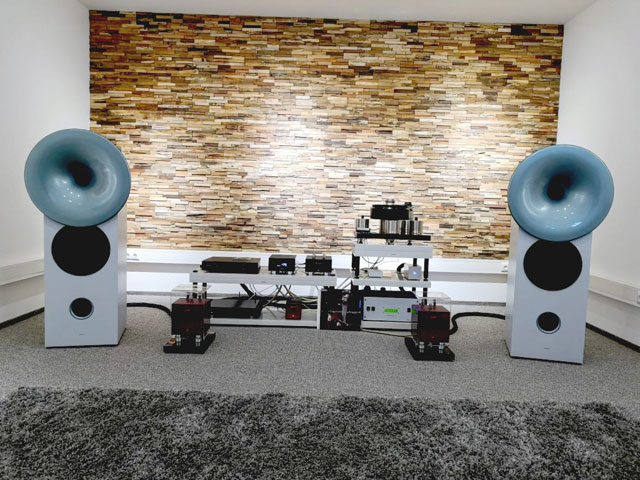
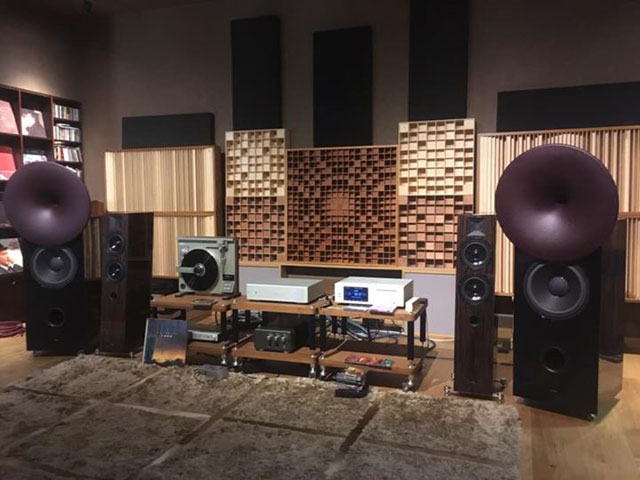



Be the first to comment on: hORNS Symphony loudspeakers by Mike Wright